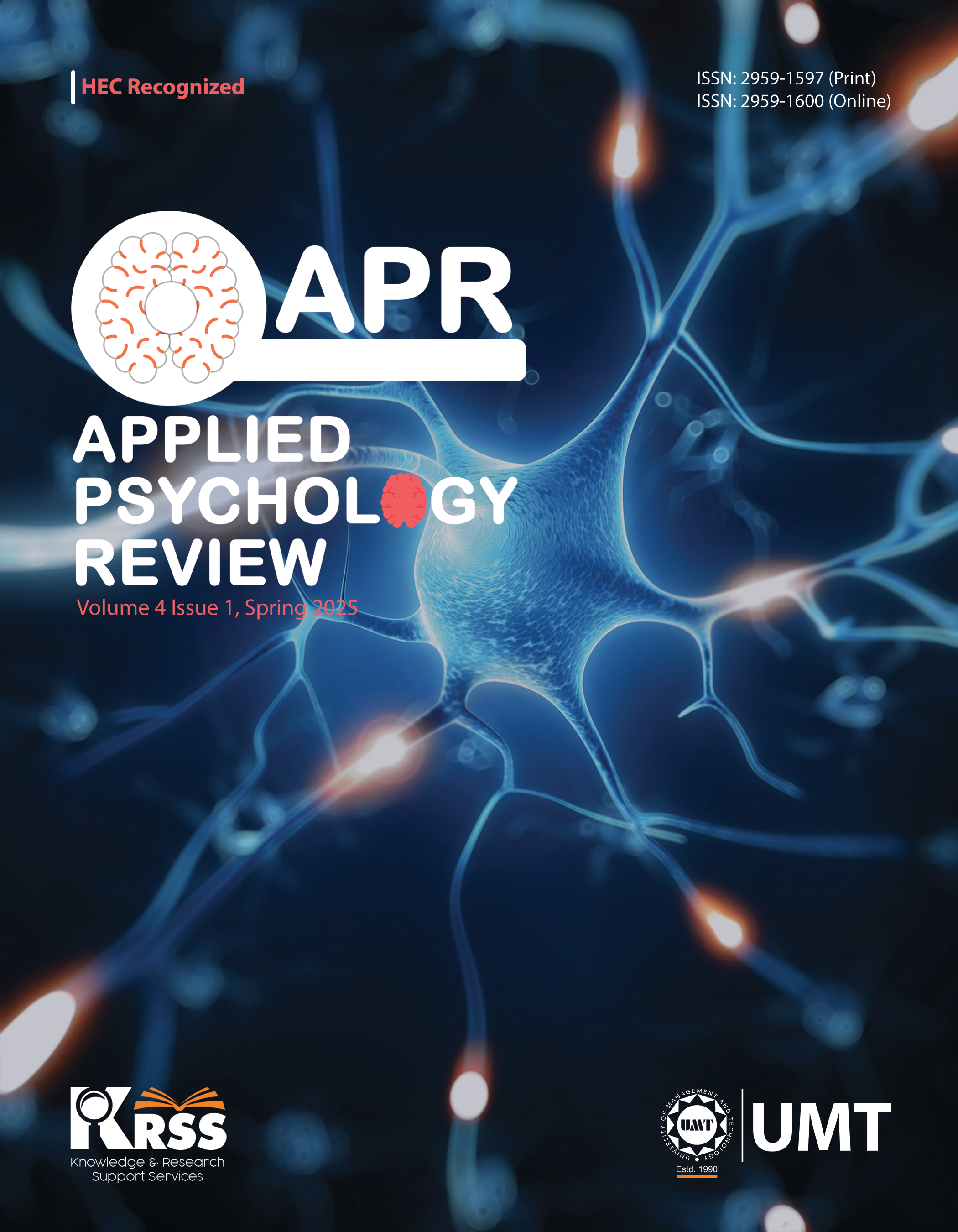Color Preference, Personality Traits and Psychosocial Functioning Among Students of Different Academic Disciplines
Abstract
 Abstract Views: 0
Abstract Views: 0
The present study aimed to explore the correlation between color preferences, personality traits, and psychosocial functioning among students from different educational backgrounds, while also examining gender-based and academic discipline differences. A correlational research design was employed, using purposive sampling to select 395 students from public and private institutions in Pakistan. Participants completed the Luscher Color Test, Big Five Personality Inventory-10, and the TCU Psychosocial Functioning Scales as assessment measures. Pearson correlations and regression analyses were conducted to test hypotheses regarding associations between color preferences and psychological traits. Results revealed that warm colors (e.g., red, yellow) were significantly correlated with extraversion, agreeableness, and conscientiousness, while dull colors (e.g., black, grey) showed strong associations with neuroticism and depression. Cool colors (e.g., blue, green) were linked to openness and decision-making, and violet was associated with hostility, depression, and childhood problems. Gender comparisons indicated that men significantly preferred violet more than women, while students in Business and IT disciplines favoured yellow and violet colors. The findings support the hypotheses and highlight the psychological relevance of color preferences in educational settings. The insights gained may inform design, pedagogy, and even therapeutic practices across gender and disciplinary lines.
Downloads
References
Baper, S., Husein, H., & Salim, S. (2021). The impact of colour on students’ perception in learning spaces. Tikrit Journal of Engineering Sciences, 28(2), 33–43. https://doi.org/10.25130/tjes.28.2.03
Biglan, A. (1973). The characteristics of subject matter in academic areas. Journal of Applied Psychology, 57, 195–203. https://doi.org/10.1037/h0034701
Bonnardel, V., Beniwal, S., Dubey, N., Pande, M., & Bimler, D. (2017). Gender difference in color preference across cultures: An archetypal pattern modulated by a female cultural stereotype. Color Research & Application, 43(2), 209–223. https://doi.org/10.1002/col.22188
Chu, Y., Wag, H., & Liu, C. (2025). Beneath the colorness skies: Does weather influence consumer color preference? Journal of Retailing and Consumer Services, 82, Article e104154. https://doi.org/10.1016/j.jretconser.2024.104154
Conner, J. W., & Scott, I. (1972). The Luscher color test. The English Journal, 61(2), 302–303. https://doi.org/10.2307/813494
Costa, P. T., & McCrae, R. R. (1992). The five-factor model of personality and its relevance to personality disorders. Journal of Personality Disorders, 6(4), 343–359. https://doi.org/10.1521/pedi.1992.6.4.343
Dehvari, H., Hosseini, I. M., & Maddahi, S. M. (2023). The effect of educational background on students' color preferences and learning outcomes. Space Ontology International Journal, 11(4), Article 43. https://doi.org/10.22094/SOIJ.2023.1964514.1506
Fider, N. A., & Komarova, N. L. (2019). Differences in color categorization manifested by males and females: A quantitative world color survey study. Palgrave Communications, 5, Article e142. https://doi.org/10.1057/s41599-019-0341-7
Fluri, J. L., & Piedalue, A. (2017). Embodying violence: Critical geographies of gender, race, and culture. Gender, Place & Culture, 24(4), 534–544. https://doi.org/10.1080/0966369x.2017.1329185
Hanafy, I., & Sanad, R. (2015). Colour preferences according to educational background. Procedia - Social and Behavioral Sciences, 205, 437–444. https://doi.org/10.1016/j.sbspro.2015.09.034
Hurlbert, A., & Ling, Y. (2012). Understanding colour perception and preference. In J. Best (Ed.), Colour design (pp. 129–157). Woodhead Publishing.
Jonauskaite, D., Epicoco, D., Al‐rasheed, A. S., Aruta, J. J. B. R., Bogushevskaya, V., Brederoo, S. G., Corona, V., Fomins, S., Gizdic, A., Griber, Y. A., Havelka, J., Hirnstein, M., John, G., Jopp, D. S., Karlsson, B., Konstantinou, N., Laurent, É., Marquardt, L., Mefoh, P. C., . . . Mohr, C. (2024). A comparative analysis of colour–emotion associations in 16–88‐year‐old adults from 31 countries. British Journal of Psychology, 115(1), 275–305. https://doi.org/10.1111/bjop.12687
Jue, J., & Ha, J. H. (2022). Exploring the relationships between personality and color preferences. Frontiers in Psychology, 13, Article e1065372 https://doi.org/10.3389/fpsyg.2022.1065372
Knight, K., Holcom, M., & Simpson, D. D. (1994). TCU Psychosocial Functioning and Motivation Scales: Manual on psychometric properties. Institute of Behavioural Research https://ibr.tcu.edu/wp-content/uploads/2013/10/kk6-srf-95.pdf
Knight, K., Simpson, D. D., & Morey, J. T. (2002). An evaluation of the TCU drug screen. PsycEXTRA Dataset. https://doi.org/10.1037/e513612006-001
Kodžoman, D. (2019). The psychology of clothing. Textile & Leather Review, 2(2), 90–103. https://doi.org/10.31881/tlr.2019.22
Kou, X., Konrath, S., & Goldstein, T. R. (2020). The relationship among different types of arts engagement, empathy, and prosocial behavior. Psychology of Aesthetics, Creativity, and the Arts, 14(4), 481–492. https://doi.org/10.1037/aca0000269
Laura, B., Claudio, Z. C., Massimiliano, Z. & Riccardo, P. (2024). Investigating the validity of the hue-heat effect on thermal sensitivity. Scientific Report, 14, Article e21413. https://doi.org/10.1038/s41598-024-71784-7
Luscher, M. (1971). Luscher color test. Washington Square Press.
Meusel, F., Scheller, N., Rey, G. D., & Schneider, S. (2024). The influence of content-relevant background color as a retrieval cue on learning with multimedia. Education and Information Technologies, (29). 16051–16072. https://doi.org/10.1007/s10639-024-12460-1
Morton, J. (2019). Why color matters. Colorcom. https://www.colorcom.com/research/why-color-matters
Nanglu, V., & Sharma, S. (2024). Colourful learning: Investigating the impact of colour-coded words on student retention. Inspa Journal of Applied and School Psychology, 6, 524–529.
Newman, A., & Obermiller, J. (n.d.). Color shapes our world. https://www.adobe.com/creativecloud/design/discover/secondary-colors.html
Ponzoni, F. J., Torres, C. M., & Magalhães, T. M. (2024). Evaluating sustainable forestry practices: A review of economic, environmental, and social dimensions. Forests, 15(6), Article e1015. https://doi.org/10.3390/f15061015
Saito, M. (2015). Comparative (cross-cultural) color preference and its structure. In R. Shamey (Ed.), Encyclopedia of color science and technology (pp. 1–7). Springer.
Schloss, K., & Palmer, S. (2017). An ecological framework for temporal and individual differences in color preferences. Vision Research, 141, 95–108. https://doi.org/10.1016/j.visres.2017.01.010
Stojić, H., Schulz, E., P. Analytis, P., & Speekenbrink, M. (2020). It’s new, but is it good? How generalization and uncertainty guide the exploration of novel options. Journal of Experimental Psychology: General, 149(10), 1878–1907. https://doi.org/10.1037/xge0000749
Sutton, T.M., & Altarriba, J. (2016). Color associations to emotion and emotion-laden words: A collection of norms for stimulus construction and selection. Behavior Research Methods, 48, 686–728. https://doi.org/10.3758/s13428-015-0598-8
Tao, B., Xu, S., Pan, X., Gao, Q., & Wang, W. (2015). Personality trait correlates of color preference in schizophrenia. Translational Neuroscience, 6(1), 174–178. https://doi.org/10.1515/tnsci-2015-0018
Teixeira, A., Brito-Costa, S., & Gomes, A. (2023). Colors in mind: A comprehensive study on the neurological impact of saturation. AHFE Open Access Journal, 142, 90–96. https://doi.org/10.54941/ahfe1005074
Tiwari, S. & Chauhan, D. (2024). Relation of personality characteristics and color preferences in working females. International Journal of Indian Psychology, 12(1), 2435–2449. https://doi.org/10.25215/1201.223
van der Voordt, T., Bakker, I., & De Boon, J. (2017). Color preferences for four different types of spaces. Facilities, 35(3/4), 155–169. https://doi.org/10.1108/f-06-2015-0043
van Hedger, S. C., Bongiovanni, N. R., & Khudhair, H. (2023, December 14). Some like it sharp: Song familiarity influences musical preference for absolute tuning. psychology of aesthetics, creativity, and the arts. Psychology of Aesthetics, Creativity, and the Arts. Advance Online Publication. https://dx.doi.org/10.1037/aca0000636
Wieloch, M., Kabzińska, K., Filipiak, D., & Filipowska, A. (2018, July 18–20). Profiling user colour preferences with BFI-44 personality traits [Paper presentation]. Business Information Systems International Workshops, Berlin, Germany.
Williams, L. A., Schofield, T. P., & Whitford, T. J. (2017). Romantic red: Testing the characteristics of color–attraction effects in a novel paradigm. Collabra: Psychology, 3(1), Article e10. http://doi.org/10.1525/collabra.54
Zong, L., Wu, S., & Duan, S. (2022). How social exclusion affects consumers' color preference. Frontiers in Psychology, 13, Article e850086. https://doi.org/10.3389/fpsyg.2022.850086
Copyright (c) 2025 Hareem Jamil, Najma Iqbal Malik

This work is licensed under a Creative Commons Attribution 4.0 International License.




